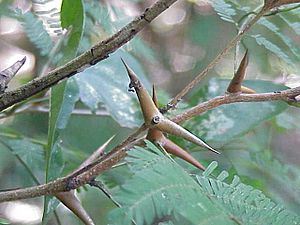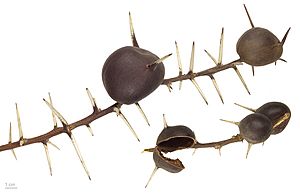Acacia sensu lato facts for kids
Quick facts for kids Acacia s.l. |
|
|---|---|
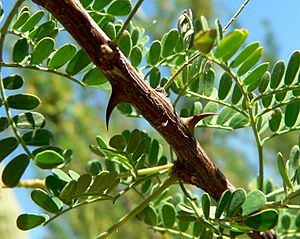 |
|
| Senegalia greggii (syn. A. greggii) | |
| Scientific classification |
|
| Kingdom: | Plantae |
| Clade: | Tracheophytes |
| Clade: | Angiosperms |
| Clade: | Eudicots |
| Clade: | Rosids |
| Order: | Fabales |
| Family: | Fabaceae |
| Clade: | Mimosoideae |
| Tribe: | Acacieae |
| Genus: | Acacia Mill. |
| Type species | |
| Acacia nilotica (until 2005) Acacia penninervis (post 2005) |
|
| Species | |
|
About 1,300; see list of Acacia species |
|
Acacia (also called mimosa, thorntree, or wattle) is a huge group of shrubs and trees. They belong to the Fabaceae family, which also includes peas and beans. These plants were first described by a Swedish scientist, Carl Linnaeus, in 1773.
Many acacia species from outside Australia have thorns. However, most Australian acacias do not. All acacias produce pods, like peas. Their sap and leaves often contain special substances called tannins. These tannins were historically used in medicines and to preserve things.
There are about 1,300 different kinds of acacia plants. This makes it the second-largest group in the Fabaceae family. Around 960 of these species come from Australia. The rest are found in warm areas around the world. You can find them in Europe, Africa, southern Asia, and the Americas.
Scientists have divided the Acacia group into five smaller groups. The name Acacia now mainly refers to the Australian species. Other species are in groups like Vachellia and Senegalia. Two smaller groups, Acaciella and Mariosousa, have species from the Americas.
Contents
What are Acacia Trees?
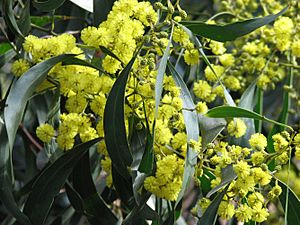
The name Acacia was first used by English botanist Philip Miller in 1754. It comes from a Greek word, akakia, which means "thorn." This name was given by an ancient Greek doctor, Pedanius Dioscorides. He used it for a medicinal tree known for its thorns. This tree, Vachellia nilotica, grows along the Nile River.
For a long time, the Acacia group included about 1,300 species. But scientists realized that the group was too broad. It contained plants that were not closely related enough. This led to a big discussion among botanists.
Eventually, scientists decided to split the Acacia group. This means the name Acacia now mostly refers to the many Australian plants. The other plants, especially those from Africa and the Americas, are now in different groups. These include Senegalia, Vachellia, Acaciella, and Mariosousa.
Acacias belong to a plant group called Mimosoideae. These plants may have developed their unique features because of dry weather and fires. This happened about 25 million years ago.
Sometimes, people mistakenly call plants from the Robinia group "acacia." For example, the "black locust" tree from America is sometimes called "false acacia" in Europe.
How Acacias Grow
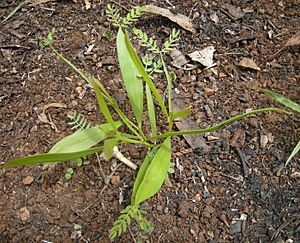
Most acacia leaves are made of many small leaflets. But in many Australian and Pacific Island species, the leaflets are gone. Instead, the leaf-stalks become flat and act like leaves. These are called "phyllodes." Phyllodes grow vertically, with their edges pointing up and down. This helps protect them from strong sunlight.
A few acacia species don't have leaves or phyllodes at all. Instead, they have flattened stems called cladodes. These stems do the job of leaves and help the plant make food.
Acacia flowers are small and have five tiny petals. These petals are almost hidden by many long stamens. The flowers grow in dense, round or cylinder-shaped clusters. Most are yellow or cream, but some can be white, purple, or even red.
Acacia flowers are different from those of a related plant, Albizia. Acacia stamens are not joined at the bottom. Also, acacia flowers have more than ten stamens, unlike Mimosa flowers.
Many acacia plants have spines, especially those in dry areas. These spines can be modified branches or leaf-parts. For example, Acacia paradoxa is called the kangaroo-thorn in Australia. Acacia erioloba is known as the camelthorn in Africa.
Acacia seeds can be hard to grow. To help them sprout, people often soak the seeds in warm water. They might also gently chip the seed coat. This can help up to 80% of the seeds grow.
Acacia and Other Living Things
Some acacia trees in Central America have large, hollow, spiny parts. These provide shelter for certain types of ants. The ants eat sweet nectar from the leaves and tiny, fatty food bodies. In return, the ants protect the acacia from plant-eating animals. Some ants even cut down other plants that compete with the acacia.
Similar partnerships happen with acacia trees in Africa. The acacias offer shelter and food to ants. The ants then protect the plant from large animals and beetles that might damage it.
There's even a spider, Bagheera kiplingi, that mostly eats parts of acacia leaves. These parts are called Beltian bodies. They are rich in protein and are also eaten by the ants that live on the acacia.
Pests of Acacia
Acacia plants can be food for the young (larvae) of certain moths. For example, some moth larvae burrow into the trunks of acacia trees. Other moth larvae, like the brown-tail moth, also feed on acacia. Some tiny leaf-mining moths also eat acacia leaves.
Acacias produce natural chemicals to protect themselves. These chemicals help defend the plants from pests and animals that might try to eat them.
Amazing Uses of Acacia
Acacia as Food
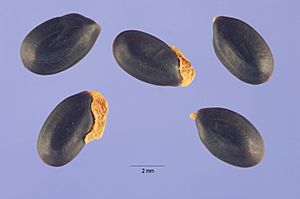
Acacia seeds are often used as food and for other products. In Myanmar, Laos, and Thailand, the young, feathery shoots of Acacia pennata are eaten. They are used in soups, curries, omelettes, and stir-fries.
Acacia Gum
Many acacia species produce a sticky substance called gum. The best-known type is gum arabic, which comes from Acacia senegal. This tree grows in dry parts of West Africa.
Vachellia nilotica (also called Acacia arabica) is another source of gum. This gum is used in many food products, like soft drinks and candies. Ancient Egyptians even used acacia gum in their paints.
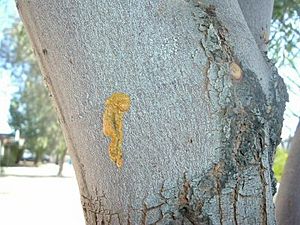
The gum from some African acacias, like Acacia xanthophloea, is sweet. Small animals like the lesser bushbaby enjoy eating it. Acacia karroo gum was once used to make sweets. It was also used as a medicine for sick cattle.
Traditional Medicine
Some acacia species have been used in traditional medicine for a long time. An old Ethiopian text describes a potion made from an acacia species to cure rabies.
A strong medicine called catechu is made from several acacia species. It's especially made from Senegalia catechu. This medicine is rich in tannins. It was made by boiling down the wood and drying the liquid.
Gardens and Security
Many acacia species are grown in gardens because they are beautiful. A. dealbata (silver wattle) is very popular. It has pretty silvery leaves and bright yellow flowers. In some places, it's mistakenly called "mimosa."
Another popular ornamental acacia is the fever tree. Florists in southern Europe use several acacia types as cut flowers. They also call these "mimosa."
Homeowners sometimes plant thorny acacia species for security. Their sharp thorns can discourage people from trespassing. This makes them a natural alternative to fences.
Perfume
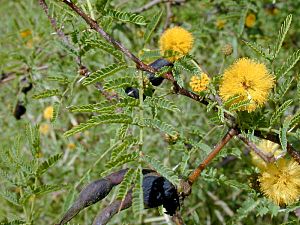
Acacia farnesiana is used in the perfume industry. This is because it has a very strong and pleasant smell. People have used acacia as a fragrance for hundreds of years.
Symbolism and Rituals
In Egyptian mythology, the acacia tree was sometimes linked to the Tree of Life. It appears in stories like the Myth of Osiris and Isis.
Parts of acacia trees, like the bark and resin, are used to make incense for rituals. This is common in India, Nepal, and China. People believe acacia smoke can keep away bad spirits and please the gods.
The Bible mentions acacia wood. In the Book of Exodus, God tells Moses to build the Ark of the Covenant from "acacia wood." Some also believe Christ's crown of thorns was made from acacia.
In Russia and Italy, yellow "mimosas" (often A. dealbata) are given to women on International Women's Day (March 8).
In 1918, Australian children's author May Gibbs wrote 'Wattle Babies'. This book describes tiny people who look like acacia flowers. They live in the Australian bush and interact with forest creatures. Gibbs wrote that "Wattle Babies are the sunshine of the Bush." This refers to the fact that many acacias bloom in Australia during winter.
Tannins for Leather
The bark of many Australian acacia species, called wattles, is rich in tannin. This is a valuable export. Important species include Acacia pycnantha (golden wattle) and Acacia decurrens (tan wattle).
Black wattle (A. mearnsii) is grown in plantations in South Africa and South America. Its bark is used for tanning leather. The pods of African acacias, like A. nilotica, are also rich in tannin. In Yemen, the leaves of the salam-tree (Acacia etbaica) were used to tan leather.
Acacia Wood
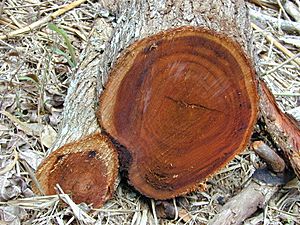
Some acacia species are valuable for their wood. A. melanoxylon (blackwood) from Australia grows very large. Its wood is used for furniture and can be polished beautifully. A. omalophylla (myall wood), also from Australia, has fragrant wood used for ornaments.
Acacia seyal is thought to be the "shittah-tree" mentioned in the Bible. Its wood was used to build the Ark of the Covenant. Acacia koa from Hawaii and Acacia heterophylla from Réunion are also excellent timber trees. Some acacia species are used as firewood in local areas. Acacia wood is also used to make homes for different animals.
Paper Production
In Indonesia and Malaysia, large farms of Acacia mangium are grown. These trees provide wood pulp for the paper industry.
Acacia wood pulp makes paper that is opaque (not see-through) and not very bulky. This is good for lightweight papers used in Bibles and dictionaries. It also makes paper tissue softer.
Helping the Land
Acacias can be planted to help stop soil erosion. This is especially useful after mining or construction has damaged the land.
Invasive Acacias
Because acacias spread easily and are tough, some types can become invasive species. This means they grow out of control and harm local plants. One example is the black wattle (A. mearnsii). It is taking over grasslands and old farms around the world. It is considered one of the world's 100 most invasive species.
Scientists recommend careful study before planting new acacia types. Once introduced, these fast-growing plants can spread quickly. They are also very hard to remove.
Famous Acacias
The Arbre du Ténéré in Niger was once the most isolated tree in the world. It stood about 400 kilometers (250 miles) from any other tree. Sadly, a truck driver knocked it down in 1973.
In Nairobi, Kenya, the Thorn Tree Café is named after a Naivasha thorn tree (Acacia xanthophloea). Travelers used to pin notes to its thorns to leave messages for others. The tree there today is the third of its kind.
See Also
- Shulgin, Alexander and Ann, TiHKAL the Continuation. Transform Press, 1997. ISBN: 978-0-9630096-9-2
- Acacia in West African plants – A Photo Guide.
Images for kids
-
Senegalia greggii (syn. A. greggii)
-
Golden wattle (Acacia pycnantha), the floral emblem of Australia
-
Acacia fasciculifera seedling in the transitional stage between pinnate leaves and phyllodes
-
Acacia dealbata seeds
-
Sap, from which gum can be made, oozing from an Acacia tree in Phoenix, Arizona
-
Egyptian goddess Isis
-
Acacia koa wood




